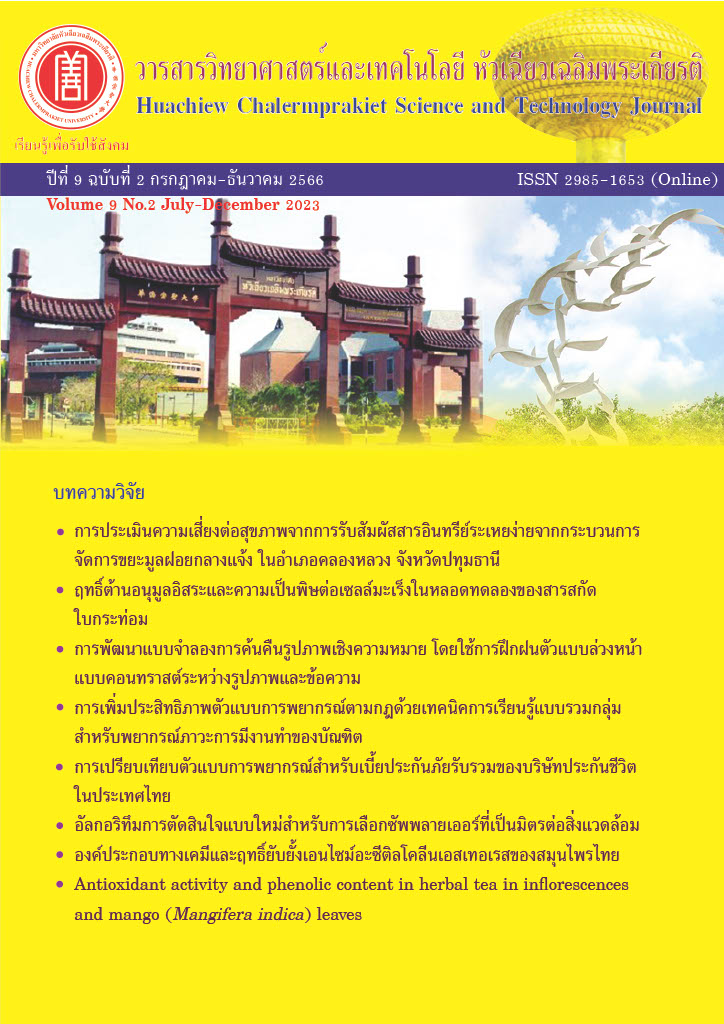ฤทธิ์ต้านอนุมูลอิสระและความเป็นพิษต่อเซลล์มะเร็งในหลอดทดลองของสารสกัดใบกระท่อม
คำสำคัญ:
ฤทธิ์ต้านอนุมูลอิสระ, ความเป็นพิษต่อเซลล์, การศึกษาในหลอดทดลอง, พืชกระท่อมบทคัดย่อ
งานวิจัยนี้มีวัตถุประสงค์เพื่อศึกษาฤทธิ์ต้านอนุมูลอิสระและความเป็นพิษต่อเซลล์มะเร็งในหลอดทดลองของสารสกัดใบกระท่อม โดยการตรวจสอบฤทธิ์ต้านอนุมูลอิสระด้วยวิธี DPPH assay และ Metal chelating assay รวมถึงการทดสอบความเป็นพิษต่อเซลล์มะเร็งในมนุษย์ ซึ่งได้แก่ เซลล์มะเร็งลำไส้ใหญ่ (HT29) เซลล์มะเร็งช่องปาก (KB) เซลล์มะเร็งเต้านม (MCF7) และเซลล์มะเร็งตับ (HepG2) ด้วยวิธี MTT assay ผลการศึกษาพบว่าสารสกัดใบกระท่อมที่ความเข้มข้นต่าง ๆ มีฤทธิ์ต้านอนุมูลอิสระแตกต่างกันอย่างมีนัยสำคัญทางสถิติ (p<0.05) โดยวีธี DPPH assay มีค่า SC50 เท่ากับ 43 ไมโครกรัมต่อมิลลิลิตร และวิธี Metal chelating assay มีค่า MC50 มากกว่า 500 ไมโครกรัมต่อมิลลิลิตร สารสกัดใบกระท่อมก่อให้เกิดความเป็นพิษสูงสุดต่อเซลล์ HepG2 (IC50= 593 ไมโครกรัมต่อมิลลิลิตร) รองลงมาคือ เซลล์ KB (IC50= 1,178 ไมโครกรัมต่อมิลลิลิตร), เซลล์ MCF7 (IC50= 1,412 ไมโครกรัมต่อมิลลิลิตร) และเซลล์ HT29 (IC50= 2,343 ไมโครกรัมต่อมิลลิลิตร) ตามลำดับ งานวิจัยนี้แสดงให้เห็นว่าสารสกัดใบกระท่อมมีศักยภาพเป็นแหล่งสารต้านอนุมูลอิสระตามธรรมชาติและสามารถนำไปพัฒนาเป็นยารักษาโรคมะเร็ง อีกทั้งเป็นหลักฐานทางวิทยาศาสตร์ที่สนับสนุนการใช้พืชกระท่อมในภูมิปัญญาไทยสำหรับการรักษาโรคมะเร็ง
เอกสารอ้างอิง
สาวิตรี อัษณางค์กรชัย, อาภา ศิริวงศ์ ณ อยุธยา. พืชกระท่อมในสังคมไทย. กรุงเทพฯ: สำนักงานคณะกรรมการป้องกันและปราบปรามยาเสพติด กระทรวงยุติธรรม; 2548.
อำพัน กิตติขจร (ขุนโสภิตบรรณลักษณ์). คัมภีร์แพทย์ไทยแผนโบราณ เล่ม 1. พระนคร: อุตสาหกรรมการพิมพ์; 2504.
อำพัน กิตติขจร (ขุนโสภิตบรรณลักษณ์). คัมภีร์แพทย์ไทยแผนโบราณ เล่ม 3. พระนคร: อุตสาหกรรมการพิมพ์; 2504.
Parthasarathy S, Azizi JB, Ramanathan S, Ismail S, Sasidharan S, Said MI, Mansor SM. Evaluation of antioxidant and antibacterial activities of aqueous, methanolic and alkaloid extracts from Mitragyna Speciosa (Rubiaceae Family) leaves. Molecules 2009;14(10):3964-74.
Mossadeq WMS, Sulaiman MR, Mohamad TAT, Chiong HS, Zakaria ZA, Jabit ML, Baharuldin MT, Israf DA. Anti-inflammatory and antinociceptive effects of Mitragyna speciosa Korth methanolic extract. Med Princ Pract 2009;18(5):378-84.
Shamima AR, Fakurazi S, Hidayat MT, Hairuszah I, Moklas MAM, Arulselvan P. Antinociceptive action of isolated mitragynine from Mitragyna Speciosa through activation of opioid receptor system. Int J Mol Sci 2012;13(9):11427-42.
Juanda E, Andayani S, Maftuch M. Phytochemical screening and antibacterial activity of kratom leaf (mitragyna speciosa korth.) against aeromonas hydrophilla. J Exp Life Sci 2019;9(3):155-8.
Yuniarti R, Nadia S, Alamanda A, Zubir M, Syahputra RA, Nizam M. Characterization, phytochemical screenings and antioxidant activity test of Kratom leaf ethanol extract (Mitragyna Speciosa Korth) using DPPH method. J Phys Conf Ser 2020;1462(1):012026.
Ponglux D, Wongseripipatana S, Takayama H, Kikuchi M, Kurihara M, Kitajima M, Aimi N, Sakai S. A new indole alkaloid, 7 alpha-Hydroxy-7H-mitragynine, from Mitragyna speciosa in Thailand. Planta Med 1994;60(6):580-1.
Xu D, Xu Z. Indole alkaloids with potential anticancer activity. Curr Top Med Chem 2020;20(21):1938-49.
กลุ่มงานดิจิทัลการแพทย์ สถาบันมะเร็งแห่งชาติ. ทะเบียนมะเร็งระดับโรงพยาบาล พ.ศ. 2564 [อินเตอร์เน็ต]. 2565 [เข้าถึงเมื่อ 15 ก.ค. 2566]. เข้าถึงได้จาก: https://www.nci.go.th/e_book/hosbased_2564/index.html
Boonpisuttinant K, Srisuttee R, Khong HY, Chutoprapat R, Ruksiriwanich W, Udompong S, Chompoo W, Boonbai R, Rakkaew R, Sangsee J, Sriprasert K, Malilas W. In vitro anti-ageing activities of ethanolic extracts from Pink rambutan (Nephelium lappaceum Linn.) for skin applications. Saudi Pharm J 2023;31(4):535-46.
Marjoni MR, Zulfisa A. Antioxidant activity of methanol extract/fractions of Senggani leaves (Melastoma candidum D. Don). Pharm Anal Acta 2017;8(8):1-6.
Zhang P, Wei W, Zhang X, Wen C, Ovatlarnporn C, Olatunji OJ. Antidiabetic and antioxidant activities of Mitragyna speciosa (kratom) leaf extract in type 2 diabetic rats. Biomed Pharmacother 2023;162:114689.
Lebedev VG, Lebedeva TN, Vidyagina EO, Sorokopudov VN, Popova AA, Shestibratov KA. Relationship between Phenolic Compounds and Antioxidant Activity in Berries and Leaves of Raspberry Genotypes and Their Genotyping by SSR Markers. Antioxidants 2022;11(10):1961.
Perron NR, Brumaghim JL. A review of the antioxidant mechanisms of polyphenol compounds related to iron binding. Cell Biochem Biophys 2009;53(2):75-100.
Kamble SH, Berthold EC, King TI, Kanumuri SRR, Popa R, Herting JR, León F, Sharma A, McMahon LR, Avery BA, McCurdy CR. Pharmacokinetics of Eleven Kratom Alkaloids Following an Oral Dose of Either Traditional or Commercial Kratom Products in Rats. J Nat Prod 2021;84(4):1104-12.
Qin R, You FM, Zhao Q, Xie X, Peng C, Zhan G, Han B. Naturally derived indole alkaloids targeting regulated cell death (RCD) for cancer therapy: from molecular mechanisms to potential therapeutic targets. J Hematol Oncol 2022;15(1):133.
Goh YS, Karunakaran T, Murugaiyah V, Santhanam R, Bakar MHA, Ramanathan S. Accelerated solvent extractions (ASE) of Mitragyna speciosa Korth. (Kratom) leaves: evaluation of Its cytotoxicity and antinociceptive activity. Molecules 2021;26(12):3704.
ดาวน์โหลด
เผยแพร่แล้ว
รูปแบบการอ้างอิง
ฉบับ
ประเภทบทความ
สัญญาอนุญาต
ลิขสิทธิ์ (c) 2023 วารสารวิทยาศาสตร์และเทคโนโลยี หัวเฉียวเฉลิมพระเกียรติ

อนุญาตภายใต้เงื่อนไข Creative Commons Attribution-NonCommercial-NoDerivatives 4.0 International License.
บทความทุกบทความที่ได้รับการตีพิมพ์ถือเป็นลิขสิทธิ์ของ คณะวิทยาศาสตร์และเทคโนโลยี มหาวิทยาลัยหัวเฉียวเฉลิมพระเกียรติ



